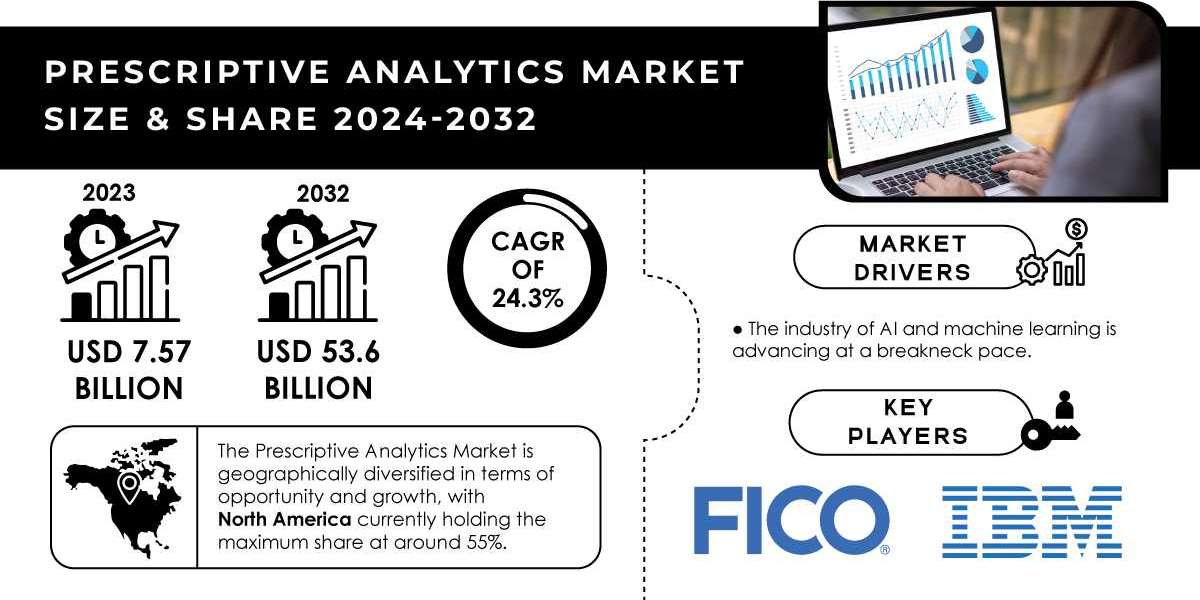Prescriptive Analytics 2024
Prescriptive analytics represents the pinnacle of data-driven decision-making, bridging the gap between descriptive and predictive analytics. By providing actionable recommendations based on data analysis and future projections, it enables organizations to optimize outcomes and streamline operations. As industries increasingly recognize the value of proactive decision-making, Prescriptive Analytics Market Trends point to its growing adoption across sectors like healthcare, retail, manufacturing, and finance.
This advanced form of analytics utilizes complex algorithms, artificial intelligence (AI), and machine learning (ML) to process large volumes of structured and unstructured data. By analyzing past trends and predicting potential future scenarios, prescriptive analytics not only suggests the best course of action but also highlights the implications of various choices. This capability is revolutionizing the way businesses plan, strategize, and adapt to dynamic market conditions.
Prescriptive Analytics Market was valued at USD 7.57 Billion in 2023 and is expected to reach USD 53.6 Billion by 2032 and grow at a CAGR of 24.3% over the forecast period 2024-2032.
How Prescriptive Analytics Enhances Decision-Making
Unlike traditional analytics tools that focus on identifying what has happened or predicting what could happen, prescriptive analytics answers the question: "What should be done?" This approach enables businesses to explore optimal solutions tailored to their goals, whether improving efficiency, reducing costs, or maximizing profits.
For instance, in supply chain management, prescriptive analytics can identify bottlenecks and recommend adjustments to minimize delays and costs. In healthcare, it suggests treatment options based on patient data, optimizing outcomes while reducing resource use. Such use cases underscore its versatility and transformative potential.
The Role of Technology in Scaling Prescriptive Analytics
The proliferation of advanced technologies like cloud computing and IoT has significantly bolstered the scalability and accessibility of prescriptive analytics. Cloud-based solutions offer businesses the ability to analyze vast datasets without investing heavily in infrastructure. IoT devices, by continuously generating real-time data, enrich the quality of inputs for analysis, ensuring more accurate recommendations.
Moreover, the integration of AI and ML into prescriptive analytics systems is enhancing their capabilities. These technologies enable the systems to learn from new data, refine algorithms, and provide increasingly precise recommendations over time. This iterative improvement cycle ensures that businesses can stay ahead of the curve in highly competitive markets.
Industry Applications and Growth Drivers
Prescriptive analytics is finding applications across diverse industries. In retail, it aids in inventory management, pricing strategies, and customer segmentation, driving higher sales and customer satisfaction. Financial institutions leverage it for fraud detection, credit risk assessment, and portfolio optimization. Manufacturing companies use it to improve production efficiency, enhance product quality, and reduce downtime.
The growing availability of big data, coupled with advancements in computational power, is a significant driver of market growth. Additionally, increasing awareness about the benefits of data-driven decision-making and the need for agility in business processes are encouraging more organizations to adopt prescriptive analytics solutions.
Challenges and Opportunities
Despite its advantages, prescriptive analytics faces challenges related to data privacy and integration. Organizations often grapple with consolidating data from disparate sources while ensuring compliance with stringent data protection regulations. Moreover, the lack of skilled personnel to manage and interpret complex analytics systems can hinder adoption.
However, these challenges present opportunities for innovation. Businesses investing in user-friendly analytics platforms, training programs, and robust cybersecurity measures can address these issues effectively. As technology evolves, the barriers to entry for smaller firms will also diminish, broadening the market scope.
Conclusion
Prescriptive analytics is reshaping the business landscape by empowering organizations with tools to make informed, proactive decisions. Its ability to recommend actionable solutions based on deep data insights is proving invaluable across industries. As adoption grows and technologies like AI and IoT become more sophisticated, the prescriptive analytics market is poised for unprecedented expansion, driving efficiency and innovation in the years to come.
Contact Us:
Akash Anand – Head of Business Development Strategy
info@snsinsider.com
Phone: +1-415-230-0044 (US) | +91-7798602273 (IND)
About Us
SS Insider is one of the leading market research and consulting agencies that dominates the market research industry globally. Our company's aim is to give clients the knowledge they require in order to function in changing circumstances. In order to give you current, accurate market data, consumer insights, and opinions so that you can make decisions with confidence, we employ a variety of techniques, including surveys, video talks, and focus groups around the world.
Read Our Other Reports:














